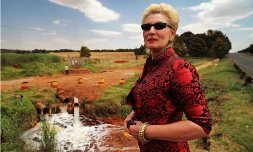We meet Mariette Lieferink in a McDonalds near Gauteng, on the edge of Johannesburg, buying a dozen sickly sweet drinks. She’s no one’s idea of a leading environmental activist. She wears a tight-fitting, scarlet, embroidered Chinese dress, high heels, and make-up. She is nearly 60, a mother of four, grandmother of two and she used to be a preacher. Now she is head of the Federation for a Sustainable Environment, and works flat out to clean up the massively polluted mining areas of Johannesburg.
Climate change, she says, is a potential disaster for Johannesburg and South Africa, liable to trigger the toxic timebomb left by 120 years of mining.
The city has been the centre of the giant South African mining industry since gold was found there in 1880, and it is surrounded by more than 400 sq m of waste dumps, tailing dams, toxic lakes, radiological hotspots, leaking pipelines, spillages, and gaping holes in the ground. More than 40,000 tonnes of gold has been mined from the Witwatersrand Basin in 120 years, as well as cadmium, uranium, cobalt, copper, zinc, manganese, titanium and other heavy metals.
Lieferink’s “toxic tour” starts on the main A28 road. The land we stand on is bright yellow and white, a deep crust of toxic waste from an old copper mine. In front of us is a brickworks making radioactive building blocks from the waste of another mine. In the distance are giant waste heaps from gold mines and below us run the shafts and tunnels of more than 120 deep mines, mostly brim full of millions of litres of some of the most toxic and hazardous waste in the world.
Climate change, she says, increases the volume of rainwater, allowing the mines to flood more frequently, and the water courses and rivers to become even more polluted. “The poorest [people] – who are confined to live near the dumps – are in the frontline. They are exposed to high concentrations of cobalt, zinc, arsenic, and cadmium, all known carcinogens, as well as high levels of radioactive uranium. In some cases, government-built houses are being erected next to radioactive dumps.”
Terrifying levels of air, ground and water pollution have been recorded, and while it’s impossible to pin cancers, mutations or respiratory diseases on individual mine companies, it is common to find children playing in the dust, ingesting poisons.
“The companies have left gaping holes in the ground and gaping holes in the social communities. They have had no regard for people, there has been no enforcement of law,” Lieferink says.
This African Erin Brokovich divides her time between the shanty towns and informal settlements near the waste dumps, and the boardrooms of the companies who are still operating. She sits on South Africa’s nuclear regulation board and is paid by two of the companies to warn local communities of the dangers of pollution. She swears it does not stop her condemning them vociferously, in public, every week.
“I got involved through Shell,” she says. “They wanted to build two petrol stations opposite my home. It was narrow self-interest that prompted me. People became tired opposing them, which left me to battle alone against them. They offered to bribe me, but eventually they gave up. It showed me what one old woman could beat a huge company.”
She then started to investigate the pollution caused by the mines, specifically what is known as “acid mine waste”, which she now believes is, along with climate change, the most dangerous issue facing South Africa.
“I am not a greenie, I just want to see justice done. I want to see the areas cleaned up.”
We head for Tudor street informal settlement, a collection of shacks built on a radioactive dump. Thirty five houses were moved from here a few years ago after Lieferink found they were on a uranium dump. The land is still highly polluted.
“When it rains here the earth becomes a yellow river. It dissolves. The children play in it. How can we deal with climate change if we cannot even manage waste like this?” she asks. “Climate change will lead here to more intense and heavier rains, so the run off will be worse. Communities are in huge danger and don’t even know,”
“The soil here is really bad. We all have health problems,” says Patience, a woman who lives there.
Despite the pressure put on her, Lieferink has no inclination to give up what she does. “My activism was at great cost, personal and financial. Industry and government have tried to discredit me. They have tried to sue me, they lambast me if I make mistakes. I am sure my emails are monitored but I am not suspicious. I am just obnoxious.”
And with that she waves goodbye to the children in the shanty town and says she will be back with a chicken for Christmas.


